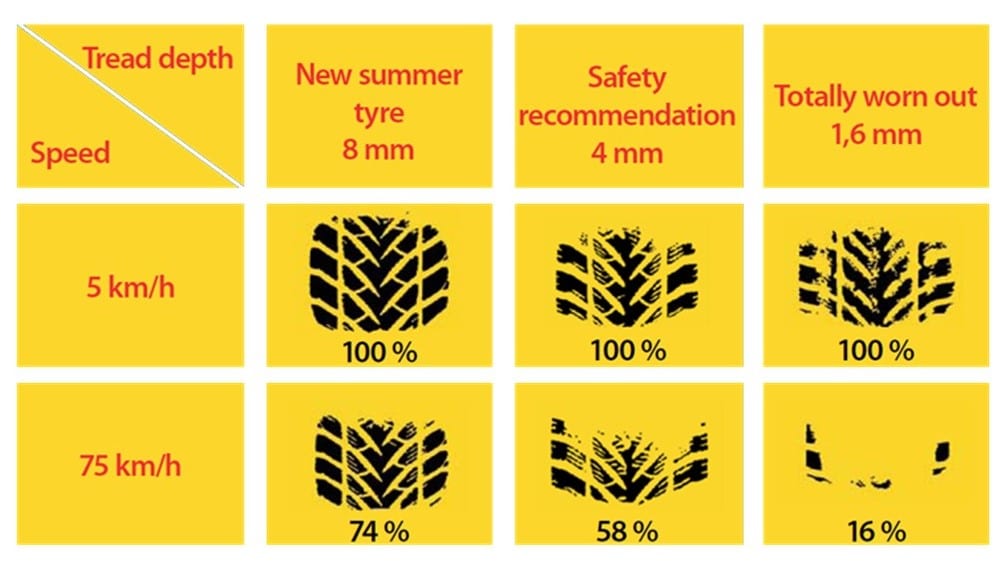-
How to prepare for winter and driving on slippery surfaces?
24 Oktober 2018 -
-
Winter and driving on slippery surfaces come with risks. Often it is the first days with slippery conditions that is most treacherous
Therefore, we want to share 5 tips that aims in giving you a safety edge and better margins to handle both your and others’ mistakes in traffic on winter roads.
Tip 1: Switch to winter tires on time! – 3 reasons to change tires on time.
- If you haven’t already switched to winter tires, then it is about time to do it now. In normal driving, the winter tires doesn’t damage either tarmac or the environment. On the contrary it can be good for the handling and road-tear if the studded tires are used before the temperature reaches below 0celsius. If you are driving on summer tires that are starting to wear out, change immediately before the autumn. On the autumn’s wet roads, the tread-depth is needed the most in order to avoid water leveling and to improve handling.
- If it turns out that the winter tires are damaged or in the need to be replaced due to wear and tear, it can pay off doing so well ahead of the first snow. When the snow starts falling, often the tire-workshops already have their schedules filled up.
- The first days of slippery conditions are treacherous. Without clear warning signals, the driving surfaces can shift quickly and surprise even the most experienced driver. With summer tires you have no chance of getting the same braking distance as with winter tires, no matter how good you are as a driver.
- Bonus: “All year tires” – Forget you ever heard of them. There are no tires that can cope with both summer temperatures and the slippery surfaces of the Swedish winters. The so-called all-year-round tires is performing poor in summer conditions and is proven useless in winter.
Tip 2: Don’t put on a pair of worn winter tires with the mindset “They’ll probably last another season …”
The road grip drastically deteriorates when using worn tires. With water or snow on the roadway, poor pattern depth will quickly decrease both braking and steering ability as the picture below shows.

Although the tyre on the picture is a summer tyre, but the principle is the same for winter tires. The safety recommendation is to replace the tires at 4-5 mm pattern depth at the latest. (The picture is taken under a glass plate with water on top)
Tip 3: Have sufficient equipment in the car
If you were to drive off the road or get a stop at the roadside, a harsh winter weather can cause major problems. Make sure that you are well equipped and that everyone using the car is aware of what equipment is available. Read more about our best tips on what to bring in the car during winter season.
Tip 4: Bring your colleagues and do some driver training on a skid course before the winter season arrives
We are happy to help you with the driver training that national Work Environment authorities recommends. The driver training will help you achieve correct driving style, mindset and risk awareness. At the skid course we provide tips and advices in order to create a safe driving on slippery surfaces. At the same time the danger of having a superstition on your own or the car’s ability is clarified in a very effective way. Under the guidance of our experienced instructors, you have an opportunity to try different reality-based scenarios on both slippery and dry surfaces. The training aims to reduce the risk of injuries and traffic accidents through effective and well-tested pedagogy.
In the driver training, we will also address other important subjects such as cargo securing, wildlife accidents, driver fatigue and much, much more.
The driver training is regularly performed all over Sweden. Driver training in other countries is also possible to arrange.
Tip 5: Drive carefully and adjust your speed
Would you like to be contacted for a customized proposal on how we can help your organization towards a safer workday?
Fill out the contact form / Call us at +468-622 57 00 / Or email to info@safeatwork.nu
Google Rating
5.0 
5.0

Danilo Metzger
13:32 30 Aug 22
Wonderful course! Easily the best course I've done. Wish ALL drivers went through it!



Martin Törnqvist
12:49 03 Oct 18
Mycket tankeväckande och lärorik utbildning för förare av utryckningsfordon. Man fick många tankeställare. Rekommenderas!



